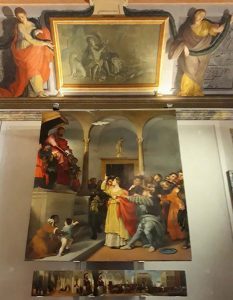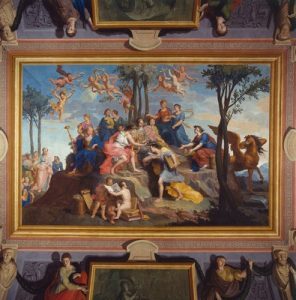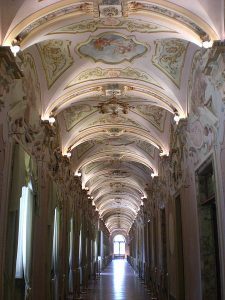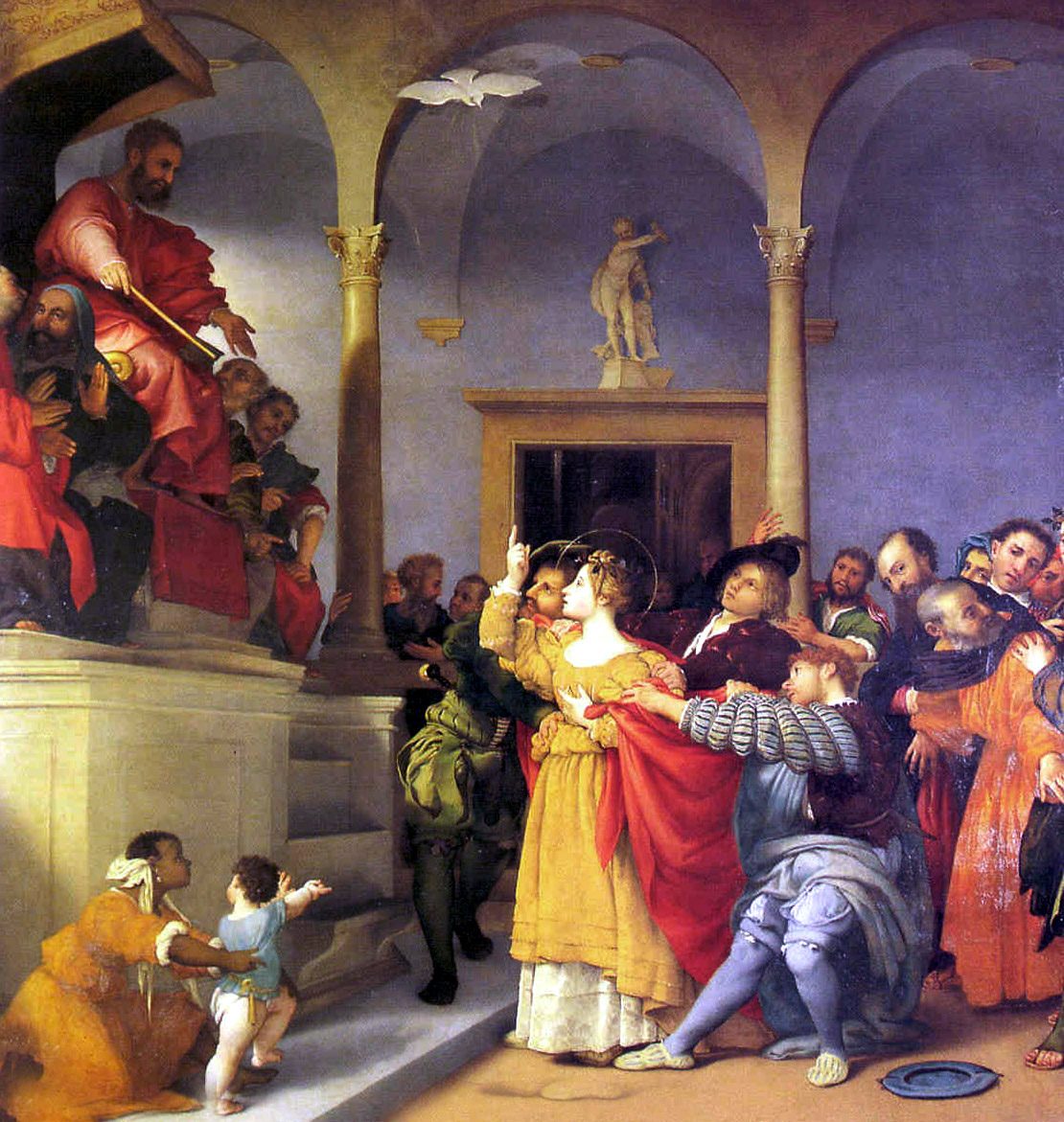{:it}Si tratta di una delle più belle opere dipinte da Lorenzo Lotto, la Pala di Santa Lucia conservata nella Pinacoteca civica di Jesi a Palazzo Pianetti, commissionata nel 1523 dalla confraternita di Santa Lucia,la più ricca della città, che gestiva l’ospedale accanto alla chiesa di San Floriano. Dopo lunga gestazione, forse per la difficoltà di essere pagato, Lotto era sempre a corto di soldi, la tavola venne consegnata, cioè nove anni dopo, nel 1532.
Di lui e della sua vita di ragazzo si sa poco, nasce a Venezia intorno al 1480 , pare da famiglia mercantile.

Ma quel che si può immaginare è il contesto di quel periodo, siamo in pieno Rinascimento, in un fervore culturale di ampio respiro e forse irripetibile, la città vive dei fasti della Serenissima, gode dei proventi dei suoi ricchi commerci e Costantinopoli è caduta da trent’anni, consegnando alla città molti preziosissimi testi in lingua greca che Aldo Manuzio avrà cura di ristampare. Tutto parla greco. Ma è anche la Venezia del Bellini e del Giorgione, del Tiziano e Sansovino. In un contesto simile, per un veneziano autentico come Lorenzo, forse la città è un pò troppo affollata , a differenza di pittori che vengono dai monti come Tiziano o dalla campagna come Giorgione che rimangono elettrizzati da quel clima culturalmente ricco, forse Lotto di Venezia ne ha fin sopra i capelli. E cosi emigra. Di lui si è detto che fosse saturnino e malinconico, che non fosse attaccato al denaro e al potere come Tiziano, che lo avversò in tutti i modi : “ O Lotto , come la bontà buono, e come la virtù virtuoso…. “ scrisse l’Aretino per suo conto.

Si può pensare che Lorenzo Lotto invece si sentisse superiore a questa sorta di vanità terrene? Che fosse un anarchico ante litteram? Forse era proprio la sua scarsità di mezzi a portarlo nella cupezza e malinconia….: “ solo, senza fidel governo, et molto inquieto della mente”, scrisse ad un certo punto della sua vita. Probabilmente l’unica cosa che gli importava veramente era la sua pittura. Un uomo sempre in fuga da se stesso , tuttavia nient’affatto semplice come lo descrive il Vasari,era solo uno che scompaginava le carte, il che non è mai un buon metodo per avere successo.
Quando si guarda la Pala del Lotto non si può non notare Lucia e il suo dito che indica il cielo, sembra una che la sa lunga e la vuole anche raccontare. Lei è una donna che argomenta, Lucia/Lux illuminata dalla luce e perciò divina, che dice a Pascasio come la pensa. Pascasio è il proconsole romano di Diocleziano, certamente non un imperatore tollerante. Lucia, che ha parlato con sua madre afflitta da una malattia e poi guarita grazie alla fede verso Sant’Agata, decide che non si sposerà, rimarrà vergine e i suoi averi li lascerà ai poveri. E questo, per il potere romano, familista e patriarcale, è dopotutto il vero sacrilegio. E’ stato detto che i cristiani dei primi secoli dopo Cristo furono perseguitati perché il loro linguaggio era rivoluzionario: davano spazio agli ultimi, alle donne e ai poveri. Fù solo in seguito, quando il Cristianesimo si fece dogma , diventò patriarcale e familista , che Costantino lo accettò come religione dell’Impero.
Lucia è ancora la minaccia al potere costituito , lei che non la smuovono nemmeno tredici buoi a cui sarà legata per essere condotta al lupanare, ci insegna che quando si crede in qualcosa niente e nessuno deve scalfirci. Qual’è la santità di Lucia, dunque, se non la sua risolutezza? Il raggio divino che scende su di noi quando non sappiamo nemmeno da dove proviene certa forza. L’uomo che ci guarda, l’unico in questa galleria movimentata di personaggi, pare invitarci ad entrare nella scena ma non solo, sembra volere la nostra opinione, ha uno sguardo da “ e voi che ne pensate?”, nel suo sorriso vagamente ironico e distaccato, da vero elemento ultraterreno del contesto. E’ Lorenzo stesso che domanda?
Perché Lorenzo in tutta la sua vita di domande deve essersene fatte molte , da qui la sua fama di uomo inquieto. Forse non trovava nemmeno molti con cui interfacciarsi e sicuramente cercava nelle Marche quella serenità d’animo che il suo bellissimo paesaggio suscita anche adesso e dove trovò quella semplicità nei rapporti umani, una spontaneità e verità nella fede che né Roma né Venezia era in grado di fornirgli.
Era molto interessato all’astronomia/astrologia e all’alchimia. Era un neoplatonico, come molti artisti e letterati dell’epoca, e ciò non fa di lui un uomo così pio e devoto come è stato maldestramente “dipinto”.
Resta inoltre da sottolineare che nel XVI secolo fosse in atto una vera e propria rivalutazione della figura femminile, che nel Cortegiano di Baldassar Castiglione prende la parola e stimola la discussione e il ragionamento.

Una Lucia da visitare e da contemplare, nella bella cornice di quella galleria Pianetti a Palazzo Pianetti di Jesi, che per la sua bellezza è anche chiamata la
” piccola Versailles”.{:}{:en}
Lorenzo Lotto, visionary genius
One of the most beautiful paintings by Lorenzo Lotto, “Pala di Santa Lucia” at the Pinacoteca Civica of Palazzo Pianetti in Jesi, commissioned in 1523 by the Confraternity of Saint Lucy, the richest of the city, that managed the hospital close to the church of Saint Floriano. Development of the painting took a long time, maybe for difficulties in being paid, Lotto was always in shortage of money, the painting was finished in 1532, i.e. nine years later.

Few information we have about the painter and his childhood, he was born in Venice circa 1480 probably from a merchant family.
You can imagine the context of that period, in the middle of the Renaissance, in a widespread cultural and perhaps unrepeatable fervor, the city becomes the “Serenissima”, enjoys the profits of its rich trades while Constantinople had lost its importance thirty years before, delivering to the city many precious Greek texts that Aldo Manuzio will reprint. Everything speaks Greek. But it is also the Venice of Bellini and Giorgione, of Titian and Sansovino. In a similar context, for a true Venetian – like Lorenzo Lotto was – perhaps the city is a little too crowded, unlike painters coming from the mountains like Titian or from the countryside like Giorgione, who remain electrified by that culturally rich climate, perhaps Lotto is fed up with Venice. And so he emigrates. He was described as saturnine and melancholic, he was not attached to money and power as Titian was, who opposed him in every way: “O Lotto, as good as goodness, and as virtuous as virtue …” Titian wrote on his behalf.
You may think that Lorenzo Lotto felt superior to this kind of earthly vanity. Was he maybe an anarchist “ante litteram”? Perhaps it was his scarcity of means to bring him into curiosity and melancholy, “alone, without faithful government, and very restless about the mind”, he wrote at some point in his life. Probably, painting was the only thing that really mattered to him. A man always escaping from himself, though not as simple as Vasari describes, he was just one who disagreed cards, which is never a good road to success.

When you look at the Lotto’s “Pala di Santa Lucia” you definitely notice Lucy and her finger pointing to the sky, it looks like she knows way too many things and she is also able to tell them. She is a woman that debates, Lucia/Lux enlightened by light and therefore divine, who tells Pascasio what she thinks. Pascasio is the Roman proconsul of Diocletian, certainly not a tolerant emperor. Lucy, who spoke with her mother afflicted by a disease and then healed thanks to her faith in Saint Agata, decides she will not marry, will remain virgin and will leave her possessions to the poor. And this is a true sacrilege to Roman familistic and patriarchal power. Christians of the first centuries were persecuted because their language was revolutionary: they gave way to poor, to women and to the “last”. It was only afterwards that, when Christianity became a dogma, it became patriarchal and familistic, so that Constantine accepted it as religion of the Empire.
Lucy is still a threat to the constituted power, she is the one who did not get hurt by thirteen oxen to which she was bound and led to the Lupanar. She teaches us that if you believe in something, then nobody can damage your belief. Isn’t Lucy’s holiness nothing more than her determination? The divine ray that comes down to us when we do not even know where it comes from. The man who looks at us, the only one in this moving gallery of characters, seems inviting us to enter the scene, but also it seems he’s asking for our opinion, “what do you think about it?”, in his smile vaguely ironic and distant, a real celestial element of the context. Is Lorenzo himself asking?
In his life Lorenzo probably asked to himself many questions, hence his reputation of being a restless man. Perhaps he did not find many people to communicate and certainly, he was looking for quietness in the region Marche, a peace of mind that the stunning landscape of the Marche was raising and still does. There he could find simplicity of human relationships, spontaneous and true faith that he could not certainly find in Rome nor Venice.
He was very interested in astronomy / astrology and alchemy. He was a neoplatonic, like many artists and writers of the time, and this does not make him such a pious and devoted man as he was dreadfully “painted”. It should also be emphasized that in the Sixteenth century a real re-evaluation of the female figure was taking place, who speaks in the “Book of the Courtier” of Baldassare Castiglione and stimulates discussion and reasoning.

Lucy deserves a visit and contemplation, in the beautiful setting of Galleria Pianetti at Palazzo Pianetti in Jesi, which for its beauty is also called the “little Versailles”.
{:}

